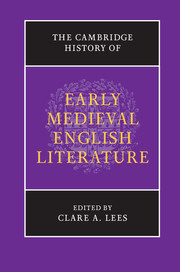Book contents
- Frontmatter
- Contents
- List of Illustrations
- List of Contributors
- Acknowledgements
- List of Abbreviations
- Introduction: literature in Britain and Ireland to 1150
- I WORD, SCRIPT AND IMAGE
- II EARLY ENGLISH LITERATURE
- III LATIN LEARNING AND THE LITERARY VERNACULARS
- 19 In measure, and number, and weight: writing science
- 20 Legal documentation and the practice of English law
- 21 Latinities, 893–1143
- 22 The authority of English, 900–1150
- 23 Crossing the language divide: Anglo-Scandinavian language and literature
- 24 European literature and eleventh-century England
- 25 Gaelic literature in Ireland and Scotland, 900–1150
- 26 Writing in Welsh to 1150: (re)creating the past, shaping the future
- Bibliography
- Index of manuscripts
- Index
23 - Crossing the language divide: Anglo-Scandinavian language and literature
from III - LATIN LEARNING AND THE LITERARY VERNACULARS
Published online by Cambridge University Press: 05 February 2013
- Frontmatter
- Contents
- List of Illustrations
- List of Contributors
- Acknowledgements
- List of Abbreviations
- Introduction: literature in Britain and Ireland to 1150
- I WORD, SCRIPT AND IMAGE
- II EARLY ENGLISH LITERATURE
- III LATIN LEARNING AND THE LITERARY VERNACULARS
- 19 In measure, and number, and weight: writing science
- 20 Legal documentation and the practice of English law
- 21 Latinities, 893–1143
- 22 The authority of English, 900–1150
- 23 Crossing the language divide: Anglo-Scandinavian language and literature
- 24 European literature and eleventh-century England
- 25 Gaelic literature in Ireland and Scotland, 900–1150
- 26 Writing in Welsh to 1150: (re)creating the past, shaping the future
- Bibliography
- Index of manuscripts
- Index
Summary
The active Scandinavian presence in England can be analysed as follows. Phases of raiding, overwintering and settlement (first recorded in 793, 850/1 and 876 respectively) ultimately led to the development of regional polities. Three of these can be distinguished within the Danelaw: the southern part of the earlier kingdom of Northumbria; the Viking half of Mercia, comprising Derby, Leicester, Lincoln, Nottingham and Stamford (later known as the Five Boroughs), and their respective counties; and parts of East Anglia. In the eleventh century the conquest and subsequent reign of Cnut saw a further significant influx of Scandinavians into England, centring on London and the south. Only the Northumbrian region lasted for long as an independent Viking lordship, and yet hundreds of linguistically Norse personal and place names are attested in the Danelaw, some of them new coinages in England, and we also note the huge Norse influence on medieval and later dialects in northern England. These factors point to the longer-term existence of communities of native Norse-speakers in that portion of the country. The end-point of these phases, complete assimilation of these communities, may reasonably be guessed to have occurred between 1100 and 1200 ce.
The kingdom of Northumbria, the Five Boroughs and London had very different histories with respect to Scandinavian activity. Equally diverse were the categories of Anglo-Scandinavian community and individual active in England. We have evidence for the presence of itinerant individuals, such as skalds, entertainers, traders, diplomats, interpreters, clergy, missionaries and mercenary warriors; itinerant groups, such as housecarls, embassies, armies and trading expeditions; groups with longer-term residency, such as the entourage at royal courts in such prestige centres as York, London and Winchester, and artisans and merchants at trading and manufacturing centres, such as York, Lincoln and London; and settled groups in the countryside, such as farmers and estate-holders. With this diversity in mind, as Dawn Hadley points out, we should not assume that the Scandinavian settlers had a common identity across or within these different regions, or that they and their descendants were bound together by inherited ethnic affiliations.
- Type
- Chapter
- Information
- The Cambridge History of Early Medieval English Literature , pp. 579 - 606Publisher: Cambridge University PressPrint publication year: 2012
- 1
- Cited by

